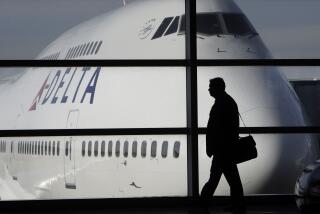Most L-1011s to Be Checked for Wing Cracks
- Share via
NEW YORK — The Federal Aviation Administration Thursday ordered that most Lockheed L-1011s be inspected after a 6 3/4-inch crack was found last week inside the wing of a Delta plane after it made a “hard landing” in Newark, N.J.
Between 90 and 100 of the 117 wide-body aircraft operating in the United States would be affected by the order. Delta, which has the largest fleet of L-1011s with 35 planes, said Thursday that it has already completed its inspections. “We found nothing,” a spokesman said.
The FAA said the order will require inspection of the rear wing support or “spar” area of all of the jumbo jets with more than 10,000 flights. The airlines must make the inspections on each plane within the next 50 flying hours.
The FAA action followed a recommendation by the National Transportation Safety Board, the agency that investigates aircraft incidents including the one Nov. 13, when Delta Flight 194 from Atlanta made what an NTSB spokesman described as a “hard landing.”
Main Structural Support
The spar is the main structural support inside the wing. Made of aluminum, it is like the girder of a building or bridge. It both supports the wing and forms one wall of the fuel tank. Should a spar break during a flight it could cause a crash. However, there are two spars in every wing and the second could keep the plane aloft, the manufacturer said.
Lockheed spokesman James Ragsdale said that a number of the aircraft have already been inspected by airlines on a voluntary basis and no other problems have been found. “At this time there is nothing to indicate the incident at Newark represents a trend and there is nothing to indicate that it is anything more than an isolated incident,” Ragsdale said. “However, you are talking about a major structural part of the aircraft and when you are talking in those terms you just can’t be too careful.”
Lockheed issued a service bulletin to all airlines that operate the 1011s recommending the type of inspection that the FAA has ordered.
The NTSB recommendation was made in a letter to FAA Administrator Donald D. Engen from Jim Burnett, chairman of the NTSB. According to the description, after the plane landed the Newark tower operator observed what appeared to be smoke coming from the right wheel brakes and notified the flight crew.
Leaking Fuel
It soon became evident that the smoke was actually fuel vapor and that fuel was leaking from the right wing near the landing gear. The plane’s engines were immediately shut down and the passengers and crew deplaned. Fuel continued to leak from the right main fuel tank. There were no reported injuries and no fire.
A witness who observed the landing of Flight 194 said that he saw what appeared to be a cloud of smoke coming from the right main landing gear while the aircraft was still about 10 feet in the air. He said that the landing did not appear to him to have been hard.
When the plane was scrutinized there was “substantial” damage to the right wing, specifically to a rear spar and to the fuel tank. Further examination revealed a complete separation of the spar between the wing root and the landing gear attachment.
Preliminary inspection of the aircraft found a 6 3/4-inch-long fatigue crack in the spar. The crack appeared to be growing rapidly, the NTSB said.
Advancing age makes all planes more likely to crack. The average age of L-1011s operated by U.S. airlines, according to a study made by The Times several months ago, rose from 5.62 years in 1980 to 8.33 years in 1984. The study also revealed that the the carriers were finding fewer cracks in the last five years but that was because they were spending less money looking for them.
250 Planes Built
A total of 250 of the aircraft were built in Palmdale, Calif., from April, 1972, through October, 1983. It is being used by seven domestic operators, including Eastern Airlines, Trans World Airlines, United Airlines and Delta Air Lines.
TWA, which has five 1011s, said it is bringing them in to its Kansas City maintenance base one at a time for the inspection and that there will be no disruption of service as a result.
Eastern Airlines said it had not yet begun the inspections but, according to a spokesman, “we cooperate fully with any investigation. We feel our planes are safe.” But, he added, a schedule is being made up for the inspection of its fleet. “You don’t get a memo in the morning and pull the planes in in the afternoon,” he said. Eastern operates 24 1011s.
United Airlines owns six 1011s but they are all newer ones. The oldest has made only 4,810 flights.
More to Read
Inside the business of entertainment
The Wide Shot brings you news, analysis and insights on everything from streaming wars to production — and what it all means for the future.
You may occasionally receive promotional content from the Los Angeles Times.









